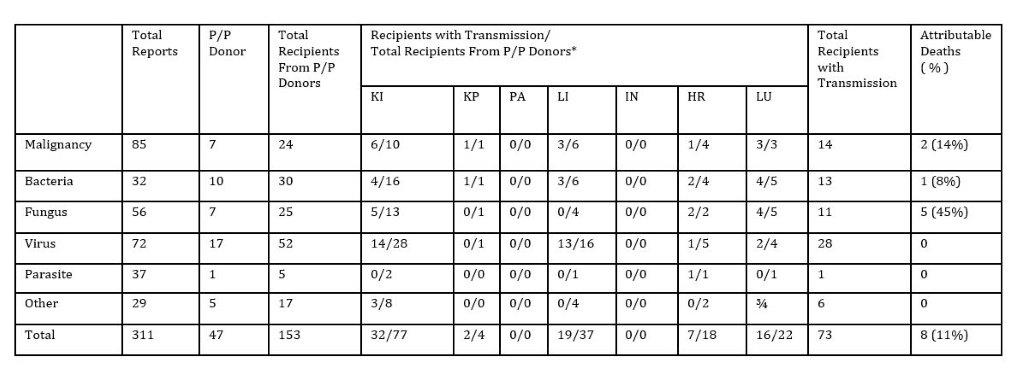Donor Derived Transmissions 2019: Analysis of the OPTN Ad Hoc Disease Transmission Advisory Committee (DTAC)
L. Danziger-Isakov1, M. G. Michaels1, A. Agarwal1, S. Aslam1, K. Dunn1, J. Goldman1, D. Levine1, C. Marboe1, G. Marklin1, S. Pouch1, M. Rana1, R. Razonable1, H. L. Stevenson1, H. S. Te1, A. Woolley1, E. Ward2, C. Jett2, L. Cartwright2, R. La Hoz1
1OPTN DTAC, Richmond, VA, 2UNOS, Richmond, VA
Meeting: 2021 American Transplant Congress
Abstract number: 1
Keywords: Bacterial infection, Fungal infection, Hepatitis, Infection
Topic: Clinical Science » Infectious Disease » All Infections (Excluding Kidney & Viral Hepatitis)
Session Information
Session Time: 10:30am-11:30am
 Presentation Time: 10:30am-10:40am
Presentation Time: 10:30am-10:40am
Location: Virtual
*Purpose: The OPTN DTAC, a multidisciplinary group, evaluates potential donor derived transmission events (PDDTE), mostly infections (I) & malignancies (M), to assess the likelihood of disease transmission.
*Methods: This is a retrospective study of PDDTE cases reported to the OPTN between 01/19 and 12/19. DTAC reviewed cases using a standardized classification algorithm.
*Results: During 2019, there were 19,258 donors and 38,425 recipients. DTAC reviewed 311/470 cases reported from donor (160) or recipient (151). 47/311 (15%) donors had proven/probable transmission(P/P Tr) of I, M or other to 73/153 (48%) exposed recipients [figure]. 22 involved living donors. Infection occurred with 35/47 P/P cases affecting 53 recipients. Viruses were most frequent P/P infections with 28 recipients having P/P Tr from 17 donors. HBV & HCV accounted for 40/72 viruses, increased from 28/48 in 2018. For bacteria, 13 recipients had P/P Tr from 10 donors. Parasites (66 reports) resulted in 1 P/P Tr in 2019 compared to 8 donors transmitting to 8 recipients with 2 attributable deaths (AD) in 2018. AD was highest for fungal infections (5/11, 45%). 7 donors with malignancies were classified as P/P impacting 14 recipients with 2 AD. 29 non-I, non-M PDDTE were reported; 5 resulted in P/P Tr to 6 recipients. Deaths from infection (N=6) occurred a median of 47 days (30-113 days), and malignancy deaths (N=2) occurred at 9-368 days.
*Conclusions: Although P/P events remain rare, 1/6 reviewed cases resulted in unanticipated P/P Tr, with parasitic decreasing and HCV/HBV increasing in 2019. This is a conservative estimate due to passive reporting and empiric interventions. Infections were most common, led by viruses. Lung recipients continue to be disproportionately represented in 2019. The DTAC continues to evaluate PDDTE to maximize organ use and assess prevention strategies to minimize transmission risk.
To cite this abstract in AMA style:
Danziger-Isakov L, Michaels MG, Agarwal A, Aslam S, Dunn K, Goldman J, Levine D, Marboe C, Marklin G, Pouch S, Rana M, Razonable R, Stevenson HL, Te HS, Woolley A, Ward E, Jett C, Cartwright L, Hoz RLa. Donor Derived Transmissions 2019: Analysis of the OPTN Ad Hoc Disease Transmission Advisory Committee (DTAC) [abstract]. Am J Transplant. 2021; 21 (suppl 3). https://atcmeetingabstracts.com/abstract/donor-derived-transmissions-2019-analysis-of-the-optn-ad-hoc-disease-transmission-advisory-committee-dtac/. Accessed July 9, 2025.« Back to 2021 American Transplant Congress

